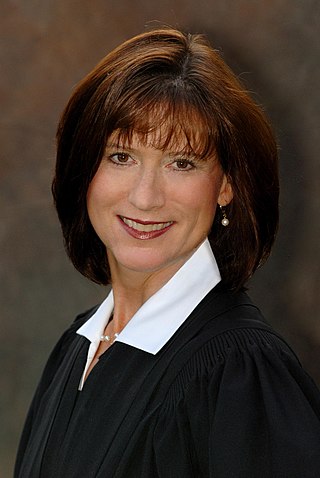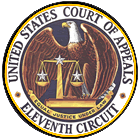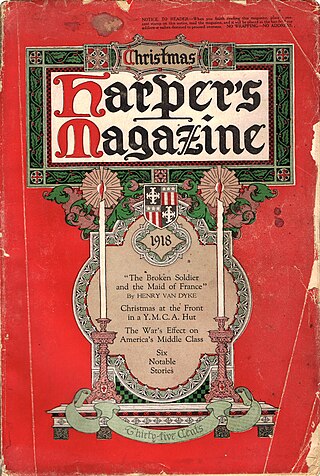Related Research Articles
In law, an en banc session is when all the judges of a court sit to hear a case, not just one judge or a smaller panel of judges. For courts like the United States Courts of Appeals in which each case is heard by a three-judge panel instead of the entire court, en banc review is usually used only for unusually complex or important cases or when the court believes there is an especially significant issue at stake. En banc is a French phrase meaning "in bench".
Neither software nor computer programs are explicitly mentioned in statutory United States patent law. Patent law has changed to address new technologies, and decisions of the United States Supreme Court and United States Court of Appeals for the Federal Circuit (CAFC) beginning in the latter part of the 20th century have sought to clarify the boundary between patent-eligible and patent-ineligible subject matter for a number of new technologies including computers and software. The first computer software case in the Supreme Court was Gottschalk v. Benson in 1972. Since then, the Supreme Court has decided about a half dozen cases touching on the patent eligibility of software-related inventions.

Silveira v. Lockyer, 312 F.3d 1052, is a decision by the United States Court of Appeals for the Ninth Circuit ruling that the Second Amendment to the United States Constitution did not guarantee individuals the right to bear arms. The case involved a challenge to the constitutionality of the Roberti-Roos Assault Weapons Control Act of 1989 (AWCA), California legislation that banned the manufacture, sale, transportation, or importation of specified semi-automatic firearms. The plaintiffs alleged that various provisions of the AWCA infringed upon their individual constitutionally-guaranteed right to keep and bear arms.

William Holcombe Pryor Jr. is an American lawyer who has served as the chief judge of the United States Court of Appeals for the Eleventh Circuit since 2020. He was appointed as a United States circuit judge of the court by President George W. Bush in 2004. He is a former commissioner of the United States Sentencing Commission. Previously, he was the attorney general of Alabama, from 1997 to 2004.

Diane Schwerm Sykes is an American jurist and lawyer who serves as the chief judge of the U.S. Court of Appeals for the Seventh Circuit. She served as a justice of the Wisconsin Supreme Court from 1999 to 2004.

Diane Pamela Wood is an American attorney who serves as the director of the American Law Institute and a senior lecturer at the University of Chicago Law School. She previously served as a circuit judge on the United States Court of Appeals for the Seventh Circuit.

Milan Dale Smith, Jr. is an American attorney and jurist serving as a United States circuit judge of the United States Court of Appeals for the Ninth Circuit. Smith's brother, Gordon H. Smith, was a Republican U.S. Senator from 1997 to 2009. Milan Smith is neither a Republican nor a Democrat, and he considers himself to be a political independent.

Fortunato Pedro Benavides was an American judge. From 1994 until 2023, he served as a United States circuit judge of the United States Court of Appeals for the Fifth Circuit.

Diarmuid Fionntain O'Scannlain is a senior United States circuit judge of the United States Court of Appeals for the Ninth Circuit. His chambers are located in Portland, Oregon.

Morton Ira Greenberg was a United States circuit judge of the United States Court of Appeals for the Third Circuit. He was nominated by President Ronald Reagan on February 11, 1987 and was confirmed by the United States Senate on March 20, 1987. He assumed senior status on June 30, 2000.
Feist Publications, Inc., v. Rural Telephone Service Co., 499 U.S. 340 (1991), was a landmark decision by the Supreme Court of the United States establishing that information alone without a minimum of original creativity cannot be protected by copyright. In the case appealed, Feist had copied information from Rural's telephone listings to include in its own, after Rural had refused to license the information. Rural sued for copyright infringement. The Court ruled that information contained in Rural's phone directory was not copyrightable and that therefore no infringement existed.

Suntrust Bank v. Houghton Mifflin Co., 268 F.3d 1257, was a case decided by the United States Court of Appeals for the Eleventh Circuit against the owner of Margaret Mitchell's 1936 novel Gone with the Wind, vacating an injunction prohibiting the publisher of Alice Randall's 2001 parody, The Wind Done Gone, from distributing the book.

Robert L. "Bob" Corn-Revere is an American First Amendment lawyer. Corn-Revere is the Chief Counsel at the Foundation for Individual Rights and Expression and was formerly a partner at Davis Wright Tremaine LLP in Washington, D.C. He is regularly listed as a leading First Amendment and media law practitioner by The Best Lawyers in America (Woodward/White), SuperLawyers Washington, D.C., and by Chambers USA. Best Lawyers in America named him as Washington, D.C.’s 2017 “Lawyer of the Year” in the areas of First Amendment Law and Litigation – First Amendment. He was again named as Best Lawyers’ “Lawyer of the Year” for First Amendment Law for 2019 and 2021, and in Media Law for 2022. In 2022 he was listed in Washingtonian Magazine's Top Lawyers Hall of Fame for Lifetime Achievement.
Kirtsaeng v. John Wiley & Sons, Inc., 568 U.S. 519 (2013), is a United States Supreme Court copyright decision in which the Court held, 6–3, that the first-sale doctrine exhausts copyright of the works lawfully made or purchased abroad.

Veeck v. Southern Bldg. Code Congress Int'l, Inc., 293 F.3d 791, was a 2002 en banc 9-6 decision of the United States Court of Appeals for the Fifth Circuit, about the scope of copyright protection for building codes and by implication other privately drafted laws adopted by states and municipal governments. A three-fifths majority of the court's fifteen judges held that copyright protection no longer applied to model codes once they were enacted into law.

A collective work in the copyright law of the United States is a work that contains the works of several authors assembled and published into a collective whole. The owner of the work has the property rights in the collective work, but the authors of the individual works may retain rights in their contributions. Electronic reproduction of the whole work is allowed, but electronic reproduction of the individual works on their own, outside the context of the work as a whole, may constitute an infringement of copyright.
Wilson v. Sellers, 584 U.S. ___ (2018), is a United States Supreme Court case concerning whether a federal court sitting in a habeas corpus proceeding should "look through" a summary ruling to review the last reasoned decision by a state court.
Uzuegbunam v. Preczewski, 592 U.S (2021), is a decision by the Supreme Court of the United States, dealing with nominal damages to be awarded to individuals whose right to freedom of speech has been suppressed by an entity but subsequently rendered moot due to intervening circumstances. In an 8–1 decision, the Court held that such nominal damages satisfy the Article Three requirement of redressability, when awarded for a past violation of a legal rights.
References
- ↑ "Greenberg v. National Geographic Enterprises Inc". American Psychological Association.
- ↑ "Greenberg v. National Geographic Society (2008)". Association of Research Libraries.
- ↑ Greenberg v. National Geographic Society, 244F.3d1267 (11th Cir.2001)("We conclude that the unauthorized use of the Greenberg photographs in the CNG compiled and authored by the Society constitutes copyright infringement that is not excused by the privilege afforded the Society under § 201(c).").
- ↑ New York Times Co. v. Tasini , 533U.S.483 (2001)("The publishers are not sheltered by § 201(c), we conclude, because the databases reproduce and distribute articles standing alone and not in context, [...]").
- ↑ Faulkner v. National Geographic Enterprises, 409F.3d26 (2nd Cir.2005)("See Tasini, 206 F.3d at 167 (Section 201(c) "protects the use of an individual contribution in a collective work that is somewhat altered."). Tasini is in that regard contrary to Greenberg.").
- ↑ Greenberg v. National Geographic Society, 488F.3d1331 (11th Cir.2007)("We conclude that the Supreme Court's decision in Tasini established a new framework for applying the § 201(c) privilege that effectively overrules the earlier panel decision in this case.").
- ↑ Greenberg v. National Geographic Society, 497F.3d1213 (11th Cir.2007)("IT IS ORDERED that the above cause shall be reheard by this court en banc.").
- ↑ Greenberg v. National Geographic Society, 533F.3d1244 (11th Cir.2008)("In the light of the Supreme Court’s holding in Tasini that the bedrock of any § 201(c) analysis is contextual fidelity to the original print publication as presented to, and perceivable by, the users of the revised version of the original publication, we agree with the Second Circuit in Faulkner and find that National Geographic is privileged to reproduce and distribute the CNG under the “revision” prong of § 201(c).").
- ↑ Tishyevich, Dmitriy. "Eleventh Circuit Applies Copyright Act's Collective Works Provision to CD-ROM Collection". JOLT Digest. Harvard Journal of Law & Technology.
- ↑ "The Complete National Geographic". The National Geographic Society. Archived from the original on September 24, 2009.